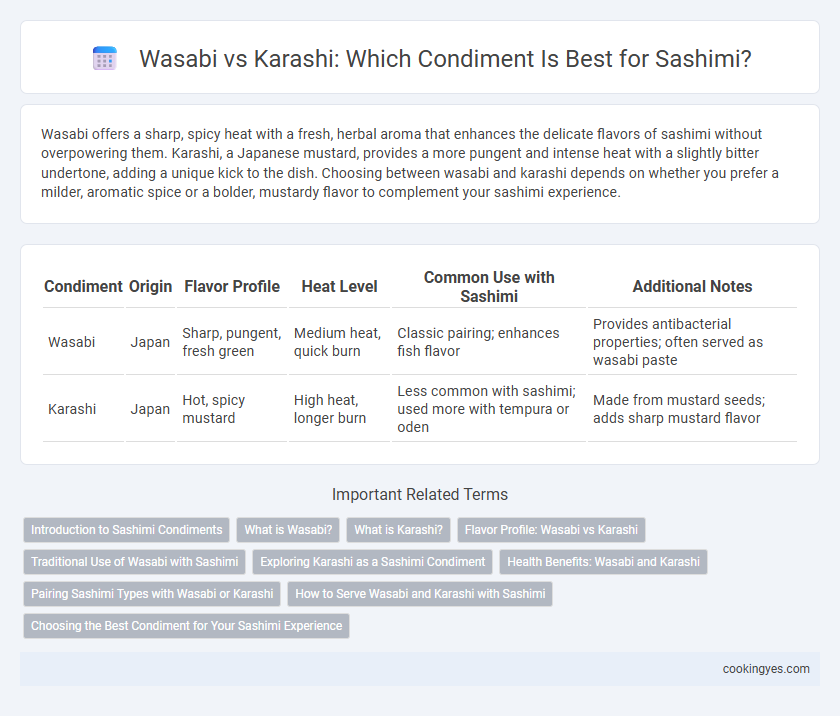Wasabi offers a sharp, spicy heat with a fresh, herbal aroma that enhances the delicate flavors of sashimi without overpowering them. Karashi, a Japanese mustard, provides a more pungent and intense heat with a slightly bitter undertone, adding a unique kick to the dish. Choosing between wasabi and karashi depends on whether you prefer a milder, aromatic spice or a bolder, mustardy flavor to complement your sashimi experience.
Table of Comparison
| Condiment | Origin | Flavor Profile | Heat Level | Common Use with Sashimi | Additional Notes |
|---|---|---|---|---|---|
| Wasabi | Japan | Sharp, pungent, fresh green | Medium heat, quick burn | Classic pairing; enhances fish flavor | Provides antibacterial properties; often served as wasabi paste |
| Karashi | Japan | Hot, spicy mustard | High heat, longer burn | Less common with sashimi; used more with tempura or oden | Made from mustard seeds; adds sharp mustard flavor |
Introduction to Sashimi Condiments
Wasabi, a pungent green paste made from Japanese horseradish, is traditionally served with sashimi to enhance its delicate flavors and provide a sharp, spicy contrast. Karashi, a type of Japanese mustard, offers a hotter and more bitter alternative but is less commonly paired with sashimi due to its overpowering taste. Selecting between wasabi and karashi depends on personal preference, with wasabi being the quintessential condiment that complements the freshness of raw fish without overshadowing it.
What is Wasabi?
Wasabi is a pungent green paste derived from the rhizome of the Wasabia japonica plant, known for its sharp, spicy flavor that complements the delicate taste of sashimi. It contains natural antimicrobial properties that can help reduce the risk of foodborne illness when consuming raw fish. Unlike Karashi, which is a mustard-based condiment with a more intense heat, Wasabi offers a fresher, cleaner heat that enhances the sashimi experience without overpowering the fish's natural flavors.
What is Karashi?
Karashi is a Japanese mustard condiment made from ground mustard seeds, known for its sharp, pungent flavor that differs from the heat of wasabi. Unlike wasabi, which offers a fresh and horseradish-like spiciness, karashi provides a more intense and dry heat, often used in Japanese cuisine to complement dishes including sashimi. This condiment enhances sashimi by adding a bold, spicy kick that contrasts with the delicate flavors of raw fish.
Flavor Profile: Wasabi vs Karashi
Wasabi offers a sharp, pungent heat that quickly dissipates, complementing sashimi's delicate flavors without overpowering them. Karashi, a Japanese mustard, presents a more robust, earthy spiciness with a lingering warmth that can mask subtle sashimi tastes. Choosing between wasabi and karashi depends on whether you prefer a clean, crisp heat that enhances or a bold, intense spice that dominates the flavor profile.
Traditional Use of Wasabi with Sashimi
Wasabi is traditionally used as a condiment for sashimi to enhance the delicate flavors of fresh raw fish, providing a sharp, aromatic heat that complements rather than overpowers the dish. Its antimicrobial properties help reduce the risk of foodborne illnesses associated with raw seafood consumption. In contrast, karashi, a Japanese mustard, is less common with sashimi and is typically reserved for other dishes like oden or tonkatsu, making wasabi the preferred and authentic accompaniment.
Exploring Karashi as a Sashimi Condiment
Karashi, a spicy Japanese mustard made from mustard seeds, offers a distinct, sharp heat that complements sashimi's delicate flavors without overpowering them. Unlike wasabi's grassy and pungent profile, karashi provides a more intense, lingering spice that enhances the natural sweetness of fresh fish such as tuna or salmon. Its dense texture and bold taste make karashi a unique alternative for sashimi enthusiasts seeking a different, robust condiment experience.
Health Benefits: Wasabi and Karashi
Wasabi contains compounds like allyl isothiocyanate that provide antimicrobial properties and support digestive health, making it a beneficial condiment for sashimi. Karashi, a type of Japanese mustard, offers antioxidants and anti-inflammatory effects due to its glucosinolate content, which may enhance metabolism and immune response. Both wasabi and karashi contribute unique health benefits, supporting digestion and offering potential protection against harmful bacteria commonly associated with raw fish consumption.
Pairing Sashimi Types with Wasabi or Karashi
Wasabi pairs best with delicate sashimi like whitefish and shellfish, enhancing their subtle flavors without overpowering them, while karashi, a sharp Japanese mustard, complements richer, fattier fish such as mackerel and tuna by cutting through their oiliness. This pairing balance highlights the natural taste and texture of each sashimi type. Understanding these condiments' flavor profiles ensures an elevated sashimi tasting experience tailored to the seafood's characteristics.
How to Serve Wasabi and Karashi with Sashimi
Serve wasabi with sashimi by placing a small amount directly on the fish or mixing it lightly into soy sauce to enhance the umami flavor without overpowering the delicate texture. Karashi, a pungent Japanese mustard, complements sashimi varieties with stronger flavors such as mackerel or octopus and is typically applied sparingly on the side or dabbed onto each bite. Ensuring both condiments are fresh and used in moderation maintains the balance between heat and the fresh, clean taste of the sashimi.
Choosing the Best Condiment for Your Sashimi Experience
Wasabi offers a sharp, sinus-clearing heat that complements sashimi's delicate flavors by enhancing the fresh, clean taste of raw fish. Karashi, a Japanese mustard, delivers a pungent, spicy kick with a more robust and earthy profile that pairs well with richer or oilier fish varieties. Choosing between wasabi and karashi depends on balancing the sashimi's texture and flavor intensity to achieve a harmonious and personalized dining experience.
Wasabi vs Karashi for sashimi condiments Infographic

 cookingyes.com
cookingyes.com